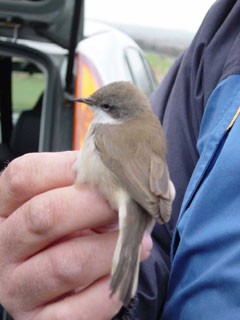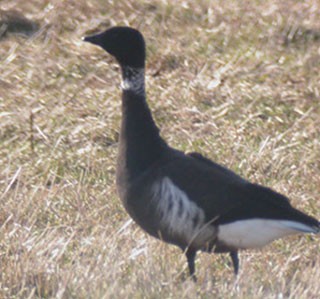It can (and does) still 'happen' well into November nowadays as the week demonstrated. High pressure over the continent and an easterly airflow ensured that 'sibes' continued to arrive, along with Desert Wheatears, whilst the 'biggie' was found on the famous island of Bardsey off the North Wales coast. I can't imagine that there were many complaints about this autumn extension though!
![]() |
![]() |
| American Robin: Bardsey, Gwynedd. The first since 1998. (Photo: Alan Clewes) |
American Robin: Bardsey, Gwynedd. (Photo: Alan Clewes) |
After a number of false starts in recent years, a new generation of birders were offered the opportunity to catch up with an American Robin when one turned up on Bardsey Island (Gwynedd) on the 11th. More frustrating was the fact that it was not possible to get onto the island on the day of its discovery, but luckily the weather abated enough on the 12th to allow those quick off the mark the opportunity to enjoy a rare sight indeed. The last British record was on Scilly in late October 1998, but we have to go back as far as 1988 for the last long-stayer, when a 1st-winter male was present in Northeast Scotland at Inverbervie at the end of December.
![]() |
![]() |
| Desert Wheatear: Climping, W. Sussex. (Photo: Ian Barnard) |
Desert Wheatear: Climping, W. Sussex. (Photo: Glyn Bridge) |
![]() |
![]() |
| Desert Wheatear: Girdle Ness, Aberdeens. (Photo: Tom Moodie) |
Desert Wheatear: Kilminning, Fife. (Photo: Andrew Whitehouse) |
Another feature of the week has been an exceptional arrival of Desert Wheatears. Late autumn birds are to be expected, but 6 were reported. These were at Climping (W. Sussex) from 9th-10th, Burnham Overy (Norfolk) from 9th-10th, Blakeney Point (Norfolk) from 9th-10th, Kilminning (Fife) from 10th onwards, Girdle Ness (Aberdeenshire) from 12th onwards and another was reported from Hodbarrow RSPB (Cumbria) on 11th. This makes the influx second only to the events of 1997 when no fewer than 15 birds arrived between November and early December, and the annual total was 18 birds. Still time yet though to accumulate a few more records!
Also a feature of the late autumn period is the expected arrival of the odd Dusky Warbler or two. However, no fewer than a dozen birds arrived during the week, with 5 in Norfolk alone. In Norfolk, birds were reported from Waxham, Wells, Sidestrand, Lessingham and Caister. Elsewhere, there were reports from Porth Clais (Pembrokeshire), Sennen (Cornwall), Pegwell Bay (Kent), Portland (Dorset), St. Mary's (Scilly), South Ronaldsay (Orkney) and the Farne Islands (Northumberland). In addition, the bird at Sumbugh (Shetland) was still present early in the week.
![]() |
| Desert Lesser Whitethroat: Filey, N. Yorks. In addition to biometrics, features of a suspected minula include: short primary projection, short bill, extensive white tail edges – have they been overlooked in the past? (Photo: John Harwood) |
A female or 1st-winter Pine Bunting was at Flamborough Head (E. Yorks) on 12th and had probably been present a couple of days; any Yellowhammer flock is worth checking at this time of year. An Olive-backed Pipit was at Spurn (E. Yorks) from 9th-10th. The exceptional numbers of sprites this autumn continued, aided by continental high pressure and easterlies. A further 7 Hume's Warblers arrived during the week, making this easily the best year for this subtle rarity. Birds were reported from Beachy Head (E. Sussex), Easington (E. Yorks), Holmpton (E. Yorks), Holy Island (Northumberland), Druridge Pools (Northumberland) and Crail (Fife), whilst Flamborough Head notched up its 4th bird of the autumn. Amazingly, a female Sardinian Warbler was found in close proximity to the long-staying male at Skegness (Lincs) on 10th. A Penduline Tit was at Dungeness (Kent) on 10th, an Arctic Redpoll was reported from Landguard (Suffolk) whilst the long-stayer remained on Unst (Shetland).
![]() |
![]() |
| Pallas's Warbler: Kilnsea, E. Yorks. (Photo: Simon Mitchie) |
Pallas's Warbler: Kilnsea, E. Yorks. (Photo: Simon Mitchie) |
Just over 30 Pallas's Warblers were noted as part of a fresh arrival along with similar numbers of Yellow-browed Warblers. There were around 15 Richard's Pipits, two late Red-breasted Flycatchers and two late Barred Warblers, plus a Desert Lesser Whitethroat at Filey (N. Yorks) from 8th-9th. A Little Bunting was at North Roe (Shetland) and the long-staying Walsey Hills (Norfolk) bird continued to entertain. A Hoopoe was in Aberdeenshire, Serins were at Portland and Sandwich Bay (Kent) and a Rose-coloured Starling was on Lewis (Outer Hebrides). Waxwings continued to provide the 'aah' factor along the east coast, with 200 in Aberdeen. Shore Larks were also reported from a number of locations, with 12 at Long Nanny (Northumberland) and 10 at Gronant (Clwyd) the maximum counts. Great Grey Shrikes continued to prove accessible in many locations with around 24 reported during the week, many at familiar wintering sites.
![]() |
![]() |
| Waxwing: Alnwick, Northumbs. (Photo: Alan Gilbertson) |
Shore Lark: Fairhaven, Lancs. (Photo: Phillip Tomkinson) |
![]() |
![]() |
| American Golden Plover: Crossen's Marsh, Lancs. (Photo: Bill Aspin) |
Ferruginous Duck: Minsmere, Suffolk. (Photo: P W Frew) |
It was not all about passerines. A 1st-winter Laughing Gull was on St. Mary's (Scilly) on 6th and 8th and a 1st-winter Bonaparte's Gull roosted on the Farne Islands (Northumberland) on 9th. An American Herring Gull was reported from Tresco (Scilly) on 10th. In Co. Donegal a grey Gyr Falcon was reported on 9th and 10th. Rare waders included juvenile Pacific Golden Plover still present on the Ythan Estuary (Aberdeenshire) with American Golden Plovers still on Fair and Fleck (Shetland), plus the bird at Crossen's Marsh (Lancs), with one on Benebecula (Outer Hebrides). A White-rumped Sandpiper was at Crookhaven (Co. Cork) on 12th, Lesser Yellowlegs in Cornwall, Co. Kerry and Pembrokeshire remain, and the Pectoral Sandpiper remained in Berkshire. It would not be November without mention of a few rare ducks though rarities were few and far between. The drake Black Scoter has returned to Llanfairfechan (Conwy), the drake Redhead remains at Kenfig (Glamorgan), the Lesser Scaup (or hybrid) was again at Foremark Reservoir (Derbyshire) and two more were reported from Benbecula. Elsewhere, there were two Ferruginous Ducks, one Ring-necked Duck, three Green-winged Teals and one American Wigeon. A Quail at Holkham (Norfolk) on the 6th was notably late.
![]() |
| Black Brant: Old Hall RSPB, Essex. (Photo: Sean Nixon) |
![]() |
![]() |
| Great Northern Diver: Ramsgate, Kent. (Photo: Dylan Wrathall) |
Jack Snipe: St. Mary's, Scilly. (Photo: Martin Goodey) |

















